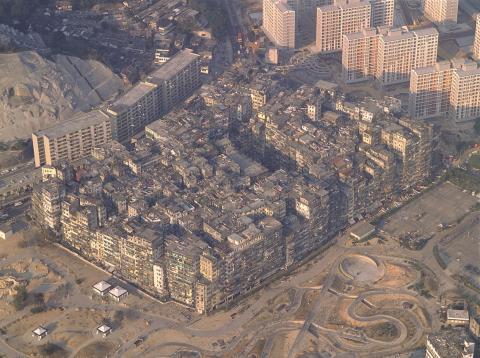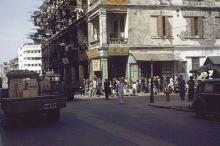Kowloon City - A brief history
Primary tabs
Thanks to Brian Coak, author of this document, for letting me post it here.
Time Line
- 1668 China establishes a watch post on site with 30 guards
- 1841 Britain occupies Hong Kong Island
- 1843 Wall is completed and China transfers soldiers to KWC
- 1847 Wall is completed as a coastal fort
- 1854 Taipings uprising captured KWC
- 1860 Kowloon Peninsula ceded to British
- 1894 Bubonic Plague
- 1898 Peking Convention (leases Hong Kong to Britain for 99 years); population 700
- 1899 Britain attacks KWC only to find it deserted
- 1900 KWC becomes a tourist destination: "a little bit of Old China"
- 1933 Hong Kong government plans to demolish of KWC and appeal to China
- 1940 Much of KWC wall demolished by the Japanese occupation except the Yamen
- 1947 Population 2000
- 1948 Hong Kong attempts to evacuate squatter population; rioting ensues
- 1950 Rampant organised crime increases
- 1963 More eviction attempts with more rioting
- 1971 Population 10,000 in 2,185 dwellings
- 1973 Over 3,500 police raids performed with over 2,500 arrests
- 1980 21-strong patrol unit established
- 1983 50 street lamps, the city's first, erected in KWC
- 1984 Sino-British joint declaration on Hong Kong's future (handover to China 1997)
- 1987 Hong Kong and Chinese Governments announce demolition of KWC
- 1991 Evacuations begin
- 1992 Evacuations complete
- 1993 Demolition of KWC
Outpost
The history of the Walled City can be traced back to the Song Dynasty (960–1279), where it served as a watch post defending the area against pirates and managing salt production.
It was rebuilt as a fort in the mid-1800s on the same site on the Kowloon Peninsula of Hong Kong. After the ceding of Hong Kong Island to Britain in 1842 in accordance to the Treaty of Nanjing, the Qing (Chinese) authorities felt it necessary for them to establish a military/administrative post to rule the area and to check further British influence in the area.
Kowloon Walled City, 1915
The Convention for the Extension of Hong Kong Territory of 1898 ceded additional parts of Hong Kong (the New Territories) to Britain for 99 years. It excluded the Walled City, with a population of roughly 700. China could continue to keep troops there without interference to Britain's temporary rule. Britain quickly reneged on this unofficial part of the agreement by attacking the Kowloon Walled City. It begged the question of the Kowloon Walled City's authority was left in the air. The outpost consisted of a yamen and other buildings which eventually grew into a low-lying, densely packed neighbourhood within the walls between the 1890s and the 1940s. The enclave remained part of Chinese territory despite the turbulent events of the early 20th century that saw the fall of the Qing government, establishment of a Republic of China in 1911 and later, the People's Republic of China in 1949.
The Walled City remained a curiosity as a tourist attraction where British colonials and tourists could have a ‘taste of the old China’.
During the WWII Japanese occupation of Hong Kong much of the city and the wall was demolished to provide building materials for the nearby Kai Tak Airport.
Triad Rule
A rare patch of sunlight in the alleys of the city.
After Japan's surrender, squatters began to occupy the Walled City, resisting several attempts by Britain in 1948 to drive them out. With no wall to protect it initially, the Walled City became a haven for triad activities and drug addicts, Due to a ‘hands off policy’ Hong Kong Police rarely entered the City. The city was left into limbo. The foundation of the People's Republic of China in 1949 thousands of refugees, many from Guangdong, added to the population.
When a murder occurred in the Walled City in 1959, it set off a small diplomatic crisis as the two nations each tried to get the other to accept responsibility for this tract of land now virtually ruled by crime syndicates.
The Triads' rule lasted until 1973–1974, when a series of over 3,000 police raids targeted them in their Kowloon Walled City stronghold.
Although the walled city was described as a hotbed of crime, charities and religious groups helped to improve the lives of residents. Schools and other community organisations were being introduced. Numerous small factories and businesses thrived inside the Walled City. The Government of Hong Kong only provided minimal services such as water and mail delivery in the city.
Boom Times
As the Triad’s hold weakened the Walled City began to grow. Squat buildings grew jowl by jowl almost coalescing like concrete mushrooms into a monolithic structure. Labyrinthine corridors ran through the City wet often clogged with refuse illuminated by garish fluorescent lights, as sunlight rarely reached the lower levels. There were only two rules for construction: illegal electric connections and the buildings could be no more than fourteen stories high, because of the nearby airport. The government failed to apply their building regulations to the Walled City buildings so all the buildings were jerry built without proper drainage. Eight municipal pipes provided water to the entire city so illegal connections were the norm.
In 1970 the writer was given a tour with the Assistant District Officer KC inside that squalid, fetid, smelly water pipe dripping Walled City. I recall seeing the old cannon in one murky and fetid narrow alley. I took a photo of the old cannon but I have no idea now what happened to the black and white photo film I took.
Later in 1974 the writer was posted to the Housing Department as Assistant Director Squatter Control - the worst job in government. Readers might recall the time of the huge influx of mainlanders of 1,000 plus per day when the PRC authorities simply just threw open the border turnstiles to anyone including criminals who wanted to come to HK.
This influx of people had no real place to live. Consequently the triads soon capitalised on the lack of accommodation by constructing flimsy huts, providing electricity and water supplies illegally. It became total war with the triads on the ground.
Many among the influx managed to find a black cranny in the government uncontrolled constructed growing multi-storey buildings in the Walled City. Many of the buildings had no piped water supply or drainage. The water and honey pot carriers made a killing.
Danger Threatened
Kai Tak Airport staff were aware the planes were already nearly shaving the flight path buildings. Hong Kong residents will remember it was a hairy and unforgettable experience flying over the city to land!
As the city was direct under the Kai Tak airport flight path the government became increasingly anxious as the buildings grew higher just around the core of the older buildings known as the 'sensitive area' many occupied by pavement bare foot dentists.
Time For Action
There was one particular building under construction already at about four or five storeys high.The Lands Department staff found scaffolding and materials at the building indicating that the builder was continuing with a view to extend it to the skies but the department failed to take any action.
A report on the matter of the uncontrolled buildings in the Walled City and this particular building was placed before the senior suits in the Secretariat. What to do? The Walled City was a real problem and hyper sensitive with the PRC authorities.
Question - leave it and close one’s eyes or knock it to prevent les autres illegal builders?
The Lands Department lamely said they could not demolish the building on the excuse that they could not bring in heavy machinery which was nonsense. I was summoned by the Secretary of Security to ask whether I could tackle the job. After long discussions with Special Branch the big question was if I demolished the growing building in the Walled City under construction would it bring a horde of local communists waving their little red books at Government House and calls for the PLA to cross the border to Hong Kong as it happened in 1967!
I agreed I would undertake the risky political job with my own squatter control men and take down the extended building brick by brick!
The job went ahead with the well planned 'attack' on the building with plenty of back up with the police and my own numerous men. On the morning of the attack I must admit I was worried when my lads commenced the work of bringing down the extension and whether I would end up being hung at a lamp post nearby by the local cadre communists or by hung by the suits in the Secretariat should I fail and start WW III.
The operation went well as planned and definitely deterred other builders in the Walled City. See the Walled City photo below. You will see a white building just off centre much shorter sandwiched between taller ones was the building shown is the one I ‘knocked’ in 1974.
The writer was probably the first and the last person Walled City ‘building knocker’ to take the risk before the whole evil, crime ridden area was smitten to the ground in 1987 when the PRC agreed the whole area would be demolished?
Life Goes on in the City of Anarchy
By the early 1980s, Kowloon Walled City had an estimated population of 35,000. The City remained notorious for its excess of brothels, casinos, opium dens, cocaine parlours, food courts serving dog meat, and secret factories. The Kowloon Walled City was also infamous for its high number of unsanitary dentist clinics, since this was where unlicensed dentists could operate without prosecution.
Evacuation and demolition
Over time, both the British and the Chinese governments found the massive, city of anarchy to be increasingly intolerable the quality of life in the city, sanitary conditions in particular, was far behind the rest of the worst of Hong Kong.
After the Joint Declaration in 1984, the PRC agreed with British authorities to demolish the City and resettle its inhabitants. The mutual decision to tear down the walled city was made in 1987.
At that time, it had 50,000 inhabitants on 0.026 km², and therefore a very high population density of 1,923,077/km², making it one of the most densely populated urban areas on Earth.
The Hong Kong Government spent some HK$ 2.7 billion in compensation to the estimated 33,000 residents and businesses in a plan devised by a special committee of the Hong Kong Housing Authority. Some residents were not satisfied with the compensation and resisted.
Evacuations started in 1991 and were completed in 1992.
In 1993 the Walled City was beginning to be torn down. After the demolition, a park was built in its place with construction starting in May 1994.
Kowloon Walled City Park
The area where the monolith once stood is now a park located in today's Kowloon City District. Completed in August 1995, the park is known as the Kowloon Walled City Park, preserving the heritage of the fabled Walled City and is part of the adjacent Carpenter Road Park.
The design of the park is based on the Jiangnan garden style of the early Qing Dynasty. It is divided into eight landscape features, with the centerpiece being the Yamen, a three-hall structure fully restored in its Qing Dynasty appearance. The Yamen houses a photo exhibition and a few relics used or found in the Walled City.
The relics of the Walled City include two cannons, five stone inscriptions and three old wells. They are preserved at various locations in the park.


